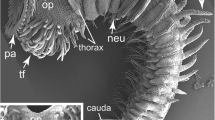Abstract
Metamorphosis and early juvenile development was followed in the laboratory in Balanus amphitrite and B. improvisus (family Balanidae) and in Semibalanus balanoides and Elminius modestus (family Archaeobalanidae) from cyprid settlement until 24 h after ecdysis. Stages of development were studied in vivo and with scanning electron microscopy. Events in metamorphosis and early juvenile development are very similar in all four species and can be interpreted in terms of a highly modified moult. Notably, there was no indication whatsoever of the “amorphous decorticated settler” previously described from metamorphosis of B. amphitrite. The shape of a juvenile barnacle with cirri and incipient shell plates is apparent immediately after the shedding of the cypris carapace, and rudimentary peduncle can be distinguished below the developing wall plates. A basal row of cuticular hairs encircles the peduncle in all species except S. balanoides. These hairs seem to serve a restraining function during early development, when the juvenile barnacle is only attached by the initially secreted cyprid cement. Similarly situated hairs are also present in very young juveniles of the lepadomorph Scalpellum scalpellum. In Semibalanus balanoides nothing indicates that the rostrum originates from the fusion of two latera as previously claimed, since this plate is single as soon as it can be distinguished.
Similar content being viewed by others
References
Bernard, F. J., Lane, C. E. (1962). Early settlement and metamorphosis of the barnacle Balanus amphitrite niveus. J. Morph. 110: 19–39
Bohart, R. M. (1929). Observations on the attachment of Balanus crenatus Brugière, found in the waters of Puget Sound. Am. Nat. 63:353–361
Darwin, C. (1854). A monograph of the sub-class Cirripedia with figures of all the species. The Balanidae; the Verrucidae etc., etc., etc. Ray Society, London, p. 1–684
Doochin, H. D. (1951). The morphology of Balanus improvisus Darwin and Balanus amphitrite niveus Darwin during initial attachment and metamorphosis. Bull. mar. sci. Gulf Caribb. 1: 15–39
Høeg, J. T. (1987). Male cyprid metamorphosis, and a new male larval form, the trichogon, in the parasitic barnacle Sacculina carcini (Crustacea: Cirripedia: Rhizocephala). Phil. Trans. R. Soc. (Ser. B), 317: 47–63
Høeg, J. T. (1992). Rhizocephala. In: Harrison, F. W., Humes, A. G. (eds.) Microscopic anatomy of invertebrates, Vol. 9. Crustacea. Wiley-Liss Inc., New York, p. 313–345
Jensen, P. G., Moyse, J., Høeg, J. T., Al-Yahya, H. (in press). Comparative SEM studies of lattice organs: putative sensory structures on the carapace of larvae from Ascothoracida and Cirripedia (Crustacea Maxillopoda Thecostraca). Acta zool., Stockh.
Kühl, H. (1968). Die Beeinflussung der Metamorphose von Balanus improvisus Darwin durch Giftstoffe. In: Proceedings of the 2nd International Congress of Marine Corrosion and Fouling. Technical Chamber of Greece, Athens p. 383–390
Newman, W. A. (1987). Evolution of cirripedes and their major groups. In: Southward, A. J. (ed.) Barnacle biology, Vol. 5. Crustacean Issues. A. A. Balkema, Rotterdam, p. 3–42
Newman, W. A. (1989). Juvenile ontogeny and metamorphosis in the most primitive living sessile barnacle, Neoverruca, from abyssal hydrothermal springs. Bull. mar. Sci. 45: 467–477
Newman, W. A., Ross, A. (1976). Revision of the balanomorph barnacles: including a catalog of the species Mem. S Diego Soc. nat. Hist. 9: 1–108
Pearse, J., Pearse, J., Buchsbaum, M., Buchsbaum, R. (1987). Living invertebrates. Blackwell Scientific, Palo Alto, California
Runnström, S. (1925). Zur Biologie und Entwicklung von Balanus balanoides. Bergens Mus. Årsberetn. Mus. 5: 1–40
Walker, G. (1971). A study of the cement apparatus of the cypris larva of the barnacle Balanus balanoides. Mar. Biol. 9: 205–212
Walker, G. (1973). The early development of the cement apparatus in the barnacle species, Balanus balanoides (L.) (Crustacea: Cirripedia). J. exp. mar. Biol. Ecol. 12: 305–314
Walley, L. J. (1969). Studies on the larval structure and metamorphosis of Balanus balanoides (L.). Phil. Trans. R. Soc. (Ser. B) 256: 237–280
Author information
Authors and Affiliations
Rights and permissions
About this article
Cite this article
Glenner, H., Høeg, J.T. Scanning electron microscopy of metamorphosis in four species of barnacles (Cirripedia Thoracica Balanomorpha). Marine Biology 117, 431–439 (1993). https://doi.org/10.1007/BF00349319
Received:
Accepted:
Issue Date:
DOI: https://doi.org/10.1007/BF00349319




